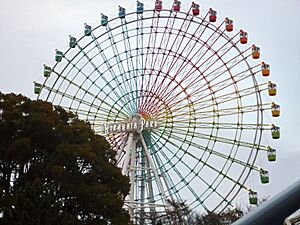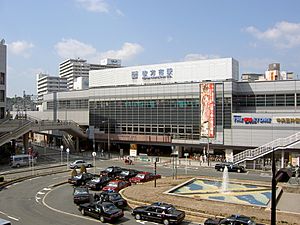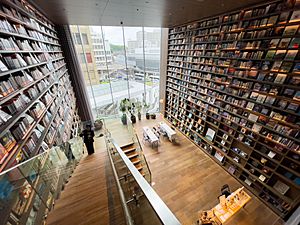Hirakata facts for kids
Quick facts for kids
Hirakata
枚方市
|
|||||||||||||
|---|---|---|---|---|---|---|---|---|---|---|---|---|---|
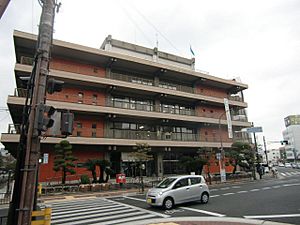
Hirakata City hall
|
|||||||||||||
|
|||||||||||||
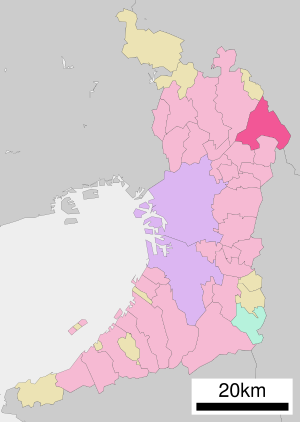
Location of Hirakata in Osaka Prefecture
|
|||||||||||||
| Country | Japan | ||||||||||||
| Region | Kansai | ||||||||||||
| Prefecture | Osaka | ||||||||||||
| Area | |||||||||||||
| • Total | 65.12 km2 (25.14 sq mi) | ||||||||||||
| Population
(December 31, 2021)
|
|||||||||||||
| • Total | 397,681 | ||||||||||||
| • Density | 6,106.9/km2 (15,816.8/sq mi) | ||||||||||||
| Time zone | UTC+09:00 (JST) | ||||||||||||
| City hall address | 2-1-20 Ogaito-chō, Hirakata-shi, Osaka-fu 573-8666 |
||||||||||||
| Climate | Cfa | ||||||||||||
|
|||||||||||||
Hirakata (枚方市 (Hirakata-shi)) is a city located in the northeastern part of Osaka Prefecture, Japan. As of December 31, 2021, about 397,681 people lived there in 183,075 homes. The city covers an area of 65.12 square kilometers (about 25.14 square miles). This means there are about 6,100 people living in each square kilometer.
Contents
- Exploring Hirakata's Location
- Hirakata's Growing Population
- A Look at Hirakata's Past
- How Hirakata is Governed
- Hirakata's Economy and Businesses
- Learning in Hirakata: Schools and Universities
- Getting Around Hirakata: Transportation
- Hirakata's International and Local Friends
- Fun Things to Do in Hirakata
- Famous People from Hirakata
- See also
Exploring Hirakata's Location
Hirakata is in the northeast of Osaka Prefecture. It sits almost exactly halfway between the big cities of Osaka and Kyoto. The city is on the left side of the Yodogawa River. It forms a triangle shape, stretching 12.0 kilometers (about 7.5 miles) north to south. The Ikoma Mountains are to the east.
Which Cities are Near Hirakata?
Hirakata shares borders with several other cities and towns.
- In Osaka Prefecture:
- Neyagawa
- Katano
- Takatsuki
- Shimamoto
- In Kyoto Prefecture:
- Yawata
- Kyōtanabe
- In Nara Prefecture:
- Ikoma
What is Hirakata's Climate Like?
Hirakata has a Humid subtropical climate. This means it has warm summers and cool winters. There is usually light or no snowfall. The average temperature each year in Hirakata is about 16.2 degrees Celsius (61.2°F). June is the month with the most rain, with an average of 194.2 millimeters (7.6 inches). August is usually the hottest month, averaging around 28.3 degrees Celsius (82.9°F). January is the coldest, with an average of 4.9 degrees Celsius (40.8°F).
| Climate data for Hirakata (1991−2020 normals, extremes 1977−present) | |||||||||||||
|---|---|---|---|---|---|---|---|---|---|---|---|---|---|
| Month | Jan | Feb | Mar | Apr | May | Jun | Jul | Aug | Sep | Oct | Nov | Dec | Year |
| Record high °C (°F) | 17.7 (63.9) |
22.7 (72.9) |
25.1 (77.2) |
31.0 (87.8) |
33.3 (91.9) |
36.3 (97.3) |
39.8 (103.6) |
39.6 (103.3) |
36.8 (98.2) |
34.0 (93.2) |
26.8 (80.2) |
25.0 (77.0) |
39.8 (103.6) |
| Mean daily maximum °C (°F) | 9.3 (48.7) |
10.2 (50.4) |
14.1 (57.4) |
20.1 (68.2) |
25.2 (77.4) |
28.1 (82.6) |
31.9 (89.4) |
33.7 (92.7) |
29.3 (84.7) |
23.5 (74.3) |
17.5 (63.5) |
11.8 (53.2) |
21.3 (70.3) |
| Daily mean °C (°F) | 4.9 (40.8) |
5.5 (41.9) |
8.9 (48.0) |
14.4 (57.9) |
19.4 (66.9) |
23.1 (73.6) |
27.1 (80.8) |
28.3 (82.9) |
24.3 (75.7) |
18.4 (65.1) |
12.5 (54.5) |
7.2 (45.0) |
16.2 (61.2) |
| Mean daily minimum °C (°F) | 1.0 (33.8) |
1.3 (34.3) |
4.2 (39.6) |
9.1 (48.4) |
14.4 (57.9) |
19.1 (66.4) |
23.4 (74.1) |
24.4 (75.9) |
20.4 (68.7) |
14.2 (57.6) |
8.1 (46.6) |
3.2 (37.8) |
12.0 (53.6) |
| Record low °C (°F) | −6.2 (20.8) |
−7.1 (19.2) |
−4.4 (24.1) |
−1.1 (30.0) |
3.2 (37.8) |
9.0 (48.2) |
15.3 (59.5) |
16.4 (61.5) |
9.4 (48.9) |
3.1 (37.6) |
−0.6 (30.9) |
−3.9 (25.0) |
−7.1 (19.2) |
| Average precipitation mm (inches) | 49.8 (1.96) |
61.6 (2.43) |
106.2 (4.18) |
102.4 (4.03) |
139.1 (5.48) |
194.2 (7.65) |
183.8 (7.24) |
142.5 (5.61) |
158.6 (6.24) |
136.7 (5.38) |
70.5 (2.78) |
53.0 (2.09) |
1,389.5 (54.70) |
| Average precipitation days (≥ 1.0mm) | 5.5 | 6.7 | 9.6 | 9.7 | 10.0 | 12.0 | 11.7 | 8.6 | 10.2 | 8.9 | 6.6 | 6.2 | 105.1 |
| Mean monthly sunshine hours | 135.0 | 128.7 | 161.2 | 184.4 | 193.4 | 141.7 | 155.9 | 204.9 | 153.9 | 158.1 | 143.2 | 139.9 | 1,912.2 |
| Source: Japan Meteorological Agency | |||||||||||||
Hirakata's Growing Population
The number of people living in Hirakata grew very quickly in the 1960s and 1970s. Since then, it has continued to grow, but at a slower pace.
| Historical population | ||
|---|---|---|
| Year | Pop. | ±% |
| 1920 | 23,714 | — |
| 1930 | 27,878 | +17.6% |
| 1940 | 39,306 | +41.0% |
| 1950 | 52,817 | +34.4% |
| 1960 | 80,312 | +52.1% |
| 1970 | 217,369 | +170.7% |
| 1980 | 353,358 | +62.6% |
| 1990 | 390,788 | +10.6% |
| 2000 | 402,563 | +3.0% |
| 2010 | 407,997 | +1.3% |
Hirakata's location near both Osaka City and Kyoto helped its population grow a lot. From around 1973 to 2013, the population became ten times larger!
Who are the Ethnic Koreans in Hirakata?
As of 2013, about 2,000 ethnic Koreans live in Hirakata. Many of them use Japanese names, even the children in school. Many Koreans in Hirakata own their own businesses. The city has a "mother's society" called "Omoni no Kai." This is a group of ethnic Korean mothers who volunteer. There are also local branches of Chongryon and Mindan. These are the two main Korean associations in Japan. Hirakata does not have specific Korean neighborhoods.
A Look at Hirakata's Past
The area where Hirakata is today was once part of an ancient region called Kawachi Province. The name "Hirakata" is very old. It appears in ancient Japanese books like the Kojiki and Nihon Shoki.
During the Asuka period (around 538-710 AD), many people from Baekje (a kingdom in the Korean Peninsula) settled here. This is shown by the early Buddhist temple of Kudara-dera. Later, during the Heian period (794-1185 AD), the hills from Katano to parts of Hirakata were known as "Katano ga Hara." This area was a hunting ground for the emperor's family. It was also famous for its beautiful cherry blossoms.
The Osaka Kaidō, which was an extension of the important Tōkaidō highway, passed through Hirakata. In the Edo Period (1603-1868 AD), Hirakata-juku became a busy post station along this highway. It was also a river port on the Yodo River.
Hirakata became an official town on April 1, 1889. It was then made a city on August 1, 1947. On April 1, 2001, Hirakata was given the special status of a special city. This gave it more local power. Then, on April 1, 2014, Hirakata became a Core city, which gave it even more local control.
How Hirakata is Governed
Hirakata has a mayor-council form of government. This means the city has a mayor who is chosen directly by the people. It also has a city council with 32 members. The city council makes laws and decisions for Hirakata. Hirakata, along with its neighbor Katano, sends four members to the Osaka Prefectural Assembly. For national politics, Hirakata is part of Osaka's 11th district. This district sends a representative to the lower house of the Diet of Japan (Japan's national parliament).
Who are Hirakata's Mayors?
Here is a list of the mayors who have led Hirakata:
- Sōichirō Terashima (1947–1955, 1959–1967)
- Harufumi Hatakeyama (1955–1959)
- Tomizō Yamamura (1967–1975)
- Kazuo Kitamaki (1975–1991)
- Kazuo Ōshio (1991–1995)
- Hiroshi Nakatsuka (1995–2007)
- Osamu Takeuchi (2007–2015)
- Takashi Fushimi (2015–present)
Hirakata's Economy and Businesses
Hirakata's modern industries started with making weapons for the Imperial Japanese Army. It also had many factories making textiles and clothing. After World War II, the old weapon factories were turned into industrial parks. Some became public housing. This helped Hirakata grow as a place where people live and travel to work in Osaka and Kyoto. Making textiles and clothing are still important industries in Hirakata today.
Companies with Offices in Hirakata
- Komatsu Osaka plant
- Sanyo Electric Co R&D
Learning in Hirakata: Schools and Universities
Hirakata has many schools and universities for students of all ages.
Colleges and Universities
- Kansai Gaidai University
- Osaka Dental University
- Kansai Medical University
- Setsunan University
- Osaka International University
- Osaka Institute of Technology
- National Tax College
Primary and Secondary Education
The city government runs 45 public elementary schools and 19 public middle schools. The Osaka Prefectural Department of Education operates six public high schools. Osaka City also runs one high school in Hirakata. There is also one private elementary school, two private middle schools, and three private high schools. The prefecture also has two special education schools for students with disabilities.
- Prefectural senior high schools:
- Osaka Prefectural Hirakata High School (大阪府立枚方高等学校)
- Osaka Prefectural Nagao High School (大阪府立長尾高等学校)
- Osaka Prefectural Makino High School (大阪府立牧野高等学校)
- Korigaoka High School (大阪府立香里丘高等学校)
- Hirakatsuda High School (大阪府立枚方津田高等学校)
- Hirakata Nagisa High School (大阪府立枚方なぎさ高等学校)
- Municipal high schools:
- Osaka City Senior High School (大阪市立高等学校)
- Private senior high schools:
- Josho Keiko Gakuen Junior and Senior High School (常翔啓光学園高等学校)
- Tokai University Gyosei Junior and Senior High School (東海大学付属仰星高等学校)
- Toyo Gakuen Nagaodani High School (長尾谷高等学校)
Getting Around Hirakata: Transportation
Hirakata has a good transportation system, including trains and highways.
Railway Lines
 JR West – Katamachi Line (Gakkentoshi Line)
JR West – Katamachi Line (Gakkentoshi Line)
- Tsuda
- Fujisaka
- Nagao
 Keihan Electric Railway - Keihan Main Line
Keihan Electric Railway - Keihan Main Line
- Kōzenji
- Hirakata-kōen
- Hirakata-shi
- Goten-yama
- Makino
- Kuzuha
 Keihan Electric Railway - Katano Line
Keihan Electric Railway - Katano Line
- Hirakata-shi
- Miyanosaka
- Hoshigaoka
- Murano
Major Highways
 Second Keihan Highway
Second Keihan Highway National Route 1 Daini Keihan Road (toll road)
National Route 1 Daini Keihan Road (toll road) National Route 168
National Route 168 National Route 170
National Route 170 National Route 307
National Route 307
Hirakata's International and Local Friends
Hirakata has special agreements with other cities, both in Japan and around the world. These are called sister city or friendship city agreements. They help build cultural ties and understanding.
 Shimanto, Kōchi, Japan – Friendship city since 1974
Shimanto, Kōchi, Japan – Friendship city since 1974 Betsukai, Hokkaidō, Japan – Friendship city since 1987
Betsukai, Hokkaidō, Japan – Friendship city since 1987 Takamatsu, Kagawa, Japan – Friendship city since 1987
Takamatsu, Kagawa, Japan – Friendship city since 1987 Changning District, Shanghai, China – Sister city since 1987
Changning District, Shanghai, China – Sister city since 1987 Logan City, Queensland, Australia – Sister city since 1995
Logan City, Queensland, Australia – Sister city since 1995
Fun Things to Do in Hirakata
Hirakata offers several interesting places to visit and explore.
- Hirakata Park: This is an amusement park with exciting rides, including wooden roller coasters.
- Hirakata T-Site: A unique building that houses a Tsutaya bookstore. It features impressive bookshelves that are 7 meters (about 23 feet) tall.
- Kudara-dera ruins: The remains of an ancient Buddhist temple.
- Kinyakurumazuka Kofun: An ancient burial mound.
- Kuzuha Battery Site: A historical site related to old military defenses.
Famous People from Hirakata
Many talented individuals from different fields have come from Hirakata.
- Hikaru Nakamura: A famous Japanese American chess player.
- Janne Da Arc: A Japanese visual kei rock band.
- Iori Kogawa: A Japanese AV Idol.
- Koichiro Yoshinaga: A former Japanese professional baseball player.
- Yuji Naka: A Japanese video game programmer and game designer. He is known for creating Sonic the Hedgehog.
- Satoshi Hashimoto: A Japanese actor and voice actor.
- Nobukazu Takemura: A Japanese musician and artist.
- Haruto Shirai: A Japanese football player.
- Kenji Honnami: A former Japanese football player.
- Yuki Kuniyoshi: A professional Japanese baseball player.
- Junichi Okada: A singer, actor, and member of the popular Japanese boy band V6.
- Katsuhisa Inamori: A former Japanese football player.
- Midori: A Japanese American violinist and classical musician.
- Kenji Moriwaki: A Japanese comedian and radio personality.
- Masahito Noto: A Japanese football player.
- Hirofumi Mukai: A Japanese professional boxer.
- Yohei Takeda: A Japanese football player and goalkeeper.
- Hisaya Morishige: A Japanese actor and comedian.
- Yuji Hino: A Japanese professional wrestler.
- Yuka Ishii: A Japanese writer.
- Takayuki Fukumura: A Japanese football player.
- Yoshimitsu Takashima: A Japanese politician and member of the House of Councillors in the Diet.
See also
 In Spanish: Hirakata para niños
In Spanish: Hirakata para niños





